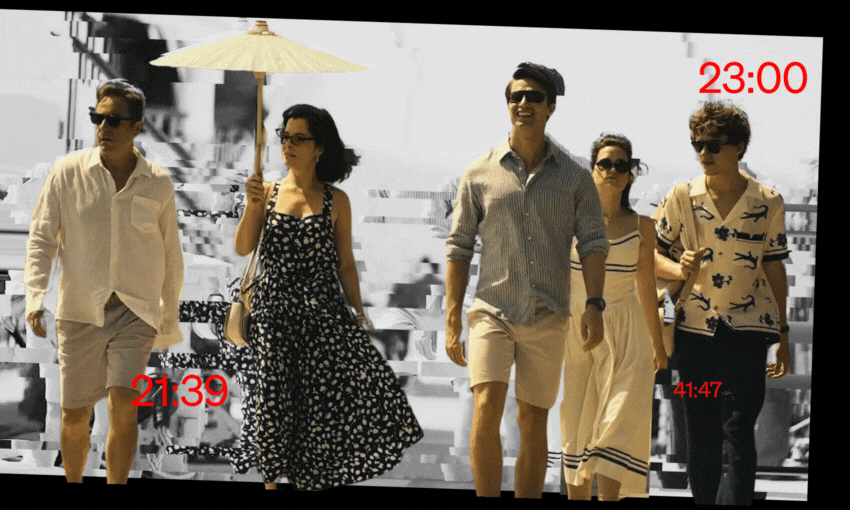Tara Ward talks to Bluey director Richard Jeffery about how a little cartoon about a Blue Heeler became one of the most beloved shows on television.
Since Bluey began in 2018, humans around the world have fallen in love with the wacky antics of a six-year-old Blue Heeler pup, her parents and little sister. Last year, Bluey was TVNZ+’s most streamed show (a whopping 29 million streams), as well as the number one programme across all on-demand platforms in Australia and the eighth most streamed show in the US. It’s won an International Emmy, several Logies and a BAFTA, and is currently broadcast in over 60 countries around the globe.
That’s a lot of kids (and more than a few adults) watching a lot of dogs playing a lot of games. Director Richard Jeffery has a theory as to why Bluey has found such astonishing global success: “Anyone can watch it with a family anywhere in the world, and say ‘Oh my god, that’s my life’,” he says over the dog and bone. It’s not every day you get to talk to someone who’s not just one of the masterminds of the show, but also a character on it. Jeffery voices a footy-loving, barbie-cooking border collie from New Zealand who is friends with Bluey and her family.
“Yes, I voiced Mackenzie’s Dad, quite badly,” Jeffery jokes, “but it was a lot of fun.”
So how did a New Zealander (and his border collie alter ego) end up on such a quintessentially Australian show? Jeffery began his animation career in New Zealand 25 years ago working for Warner Bros and Disney, before moving to the UK, where he worked on popular children’s TV shows like Charlie and Lola and Tinga Tinga Tales. It was there that he met fellow animator Joe Brumm. Years later, when Jeffery had returned to New Zealand and Brumm to Australia, Brumm called to pitch a new animated children’s TV show called “Bluey” about a curious young pup and her loveable family.
“It was an easy yes,” says Jeffery. He joined Blue as an animator in season one and later became director for seasons two and three. He’s not the only New Zealand connection to the show: the characters of pup Mackenzie and his border collie family, who speak with distinct New Zealand accents, are a small homage to Footrot Flats, says Jeffery. “Growing up, Joe [Brumm] loved Footrot Flats, it was one of his big influences. He really, really enjoyed the comic book series. And, you know, having a Kiwi director and animator, he wanted to get a bit of Kiwi influence in there.”
Trans-Tasman relations aside, Bluey also captures the small but beautiful (as well as the frustrating and annoying) moments of family life, telling sweet stories with a gentle charm and warm humour. Parents watching Bluey for the nine millionth time will understand the struggles of Bluey’s frazzled parents Bandit and Chilli, while children will adore watching Bluey and her pals turn everyday experiences – like visiting the supermarket or a picnic at the park – into creative adventures. “Bluey is essentially based around how kids learn through play, and so kids can see those moments and recognise them.”
This broad appeal was always the show’s intention, Jeffery says, and he credits the writing for creating mature storylines and heartfelt moments that connect with viewers far beyond the show’s traditional four-to-six-year-old audience. Several episodes touch on big life issues like separation, infertility, loss and change, explained in ways that children can understand but with enough emotional depth and relatability to bring tears to an adult’s eyes. Jeffery reckons the Australian setting helps too, with the series recognisably set (and entirely produced) in Brisbane. “It brings a little flavour to it, which translates well.”
What also translates well is the refreshing way Bluey reflects modern day parenting. Bandit and Chilli seem to have an endless amount of patience for playing yet another game of Magic Xylophone, and while that might make the really lazy parents among us feel bad, there’s no room for a hapless Daddy Pig-type of parent on Bluey. “We wanted to make Bandit break the mould of the classic dad being a bit of a dunce,” Jeffery says. The parents on Bluey don’t have all the answers, just like the rest of us pooches, but they’re devoted to finding them out.“We want the audience to know that they’re not the only ones going through it, you know?”
As director of Bluey, Jeffery works across the entire production, from editing to art direction to music, and while he’s not giving much away about the new season, he does reveal it’s full of classic Bluey humour and many more touching moments. It also includes a special guest appearance from music icon Neil Finn. Jeffery says it was a delight to meet Finn (who voices Bandit’s doctor in ‘Exercise’), and that Sam Neill, Lucy Lawless and Jeremy Wells are next on his famous New Zealander cameo wish list.
Even in the show’s hectic early days, Jeffery says he could sense there was something special about Bluey. ”It was definitely our intention to make the best show that we could, and we really set the bar high,” he says. He’s proud of making a show that has become a household name around the world, one so beloved that a generation of children and their whānau will grow up watching it together. “To be honest with you, we went beyond our expectations,” Jeffery says, “but it’s been amazing.”
Bluey is available to stream on TVNZ+.



